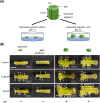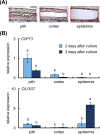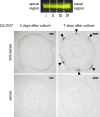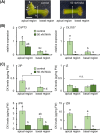Ectopic expression of LONELY GUY7 in epidermis of internodal segments for de novo shoot regeneration without phytohormone treatment in ipecac
- PMID: 39723728
- PMCID: PMC11670440
- DOI: 10.1111/ppl.70023
Ectopic expression of LONELY GUY7 in epidermis of internodal segments for de novo shoot regeneration without phytohormone treatment in ipecac
Abstract
In many plant species, the application of exogenous phytohormones is crucial for initiating de novo shoot regeneration. However, ipecac [Carapichea ipecacuanha (Brot) L. Andersson] has a unique ability to develop adventitious shoots on the epidermis of internodal segments without phytohormone treatment. This characteristic allows us to evaluate the effects of endogenous phytohormones in this species. Here, we showed that the presence of the pith, including vascular bundles in the internodal segment, is required to activate both endogenous cytokinin (CK) biosynthesis and adventitious shoot formation. Adventitious shoots were mainly formed in the apical region of internodal segments, where the CK biosynthesis genes ISOPENTENYL TRANSFERASE 3 (CiIPT3) and LONELY GUY 7 (CiLOG7) were spontaneously upregulated in the early culture stage on phytohormone-free medium. In addition, CiIPT3 and CiLOG7 were respectively expressed in the pith and the epidermis of the internodal segments. The expression of CiLOG7 was localized as several spots on the epidermis. These findings suggest that CK precursors are generated in the pith, transferred to the epidermis, and then converted into active CKs, facilitating adventitious shoot formation on the epidermis. Conversely, auxin levels rapidly decreased during culture and remained low in the region of shoot formation. Auxin is transferred to the basal region of internodal segments, and strongly suppressed the CiLOG7 expression and decreased the CK levels. Thus, we conclude that the ectopic expression of CiLOG7 in the epidermis of internodal segments contributes to de novo shoot regeneration in ipecac.
© 2024 The Author(s). Physiologia Plantarum published by John Wiley & Sons Ltd on behalf of Scandinavian Plant Physiology Society.
Figures






Similar articles
-
Endogenous auxin determines the pattern of adventitious shoot formation on internodal segments of ipecac.Planta. 2020 Mar 5;251(3):73. doi: 10.1007/s00425-020-03367-5. Planta. 2020. PMID: 32140780
-
Increase in ENHANCER OF SHOOT REGENERATION2 expression by treatment with strigolactone-related inhibitors and kinetin during adventitious shoot formation in ipecac.Plant Cell Rep. 2023 Dec;42(12):1927-1936. doi: 10.1007/s00299-023-03073-y. Epub 2023 Oct 6. Plant Cell Rep. 2023. PMID: 37803214
-
Gene expression profiling before and after internode culture for adventitious shoot formation in ipecac.BMC Plant Biol. 2022 Jul 22;22(1):361. doi: 10.1186/s12870-022-03756-w. BMC Plant Biol. 2022. PMID: 35869421 Free PMC article.
-
Integrating the Roles for Cytokinin and Auxin in De Novo Shoot Organogenesis: From Hormone Uptake to Signaling Outputs.Int J Mol Sci. 2021 Aug 9;22(16):8554. doi: 10.3390/ijms22168554. Int J Mol Sci. 2021. PMID: 34445260 Free PMC article. Review.
-
Cytokinin Signaling and De Novo Shoot Organogenesis.Genes (Basel). 2021 Feb 12;12(2):265. doi: 10.3390/genes12020265. Genes (Basel). 2021. PMID: 33673064 Free PMC article. Review.
References
-
- Catterou M, Dubois F, Smets R, Vaniet S, Kichey T, Van Onckelen H, Sangwan‐Norreel BS, Sangwan RS (2002) hoc: an Arabidopsis mutant overproducing cytokinins and expressing high in vitro organogenic capacity. Plant J 30(3): 273–287 - PubMed
-
- Cheng ZJ, Wang L, Sun W, Zhang Y, Zhou C, Su YH, Li W, Sun TT, Zhao XY, Li XG, Cheng Y, Zhao Y, Xie Q, Zhang XS (2013) Pattern of auxin and cytokinin responses for shoot meristem induction results from the regulation of cytokinin biosynthesis by AUXIN RESPONSE FACTOR3. Plant Physiol 161(1): 240–251 - PMC - PubMed
-
- Duclercq J, Sangwan‐Norreel B, Catterou M, Sangwan RS (2011a) De novo shoot organogenesis: from art to science. Trends Plant Sci 16(11): 597–606 - PubMed
-
- Duclercq J, Assoumou Ndong YP, Guerineau F, Sangwan RS, Catterou M (2011b) Arabidopsis shoot organogenesis is enhanced by an amino acid change in the ATHB15 transcription factor. Plant Biol 13(2): 317–324 - PubMed
MeSH terms
Substances
Grants and funding
LinkOut - more resources
Full Text Sources
Research Materials

